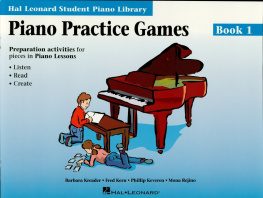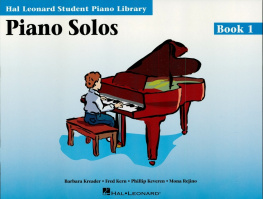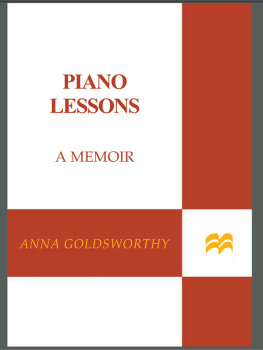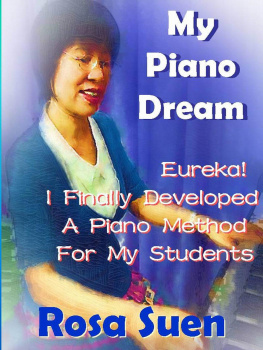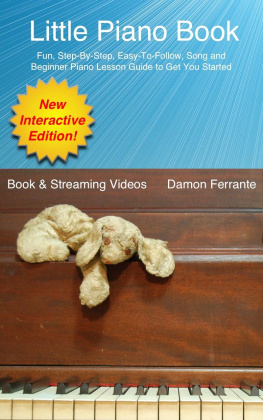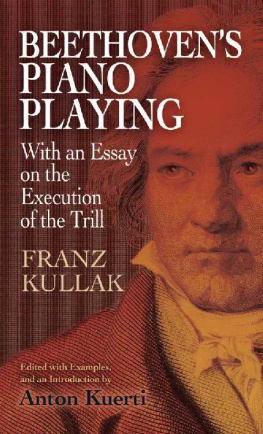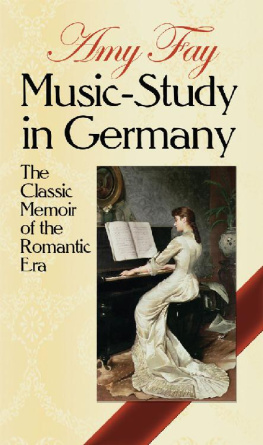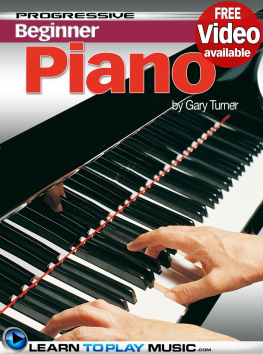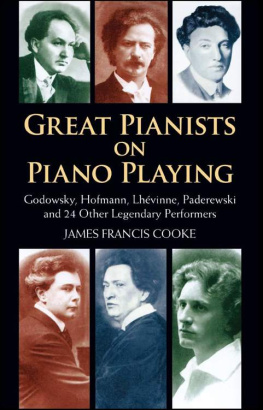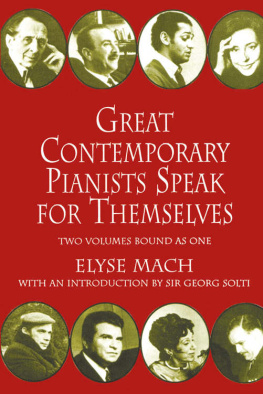Piano Lessons with Claudio Arrau

Arrau and pupils at Lewisohn Stadium on the campus of the City College of New York. Left to right: Roberto Eyzaguirre, Germn Diez, Norman Klekamp, Claudio Arrau, Esther Bernstein, June Eyzaguirre, Goodwin Sammel, Alfonso Montecino. Photo by Josefina Megret. Courtesy of Germn Diez.
Piano Lessons with Claudio Arrau
A Guide to His Philosophy
and Techniques
VICTORIA A. VON ARX


Oxford University Press is a department of the University of Oxford. It furthers the Universitys objective of excellence in research, scholarship, and education by publishing worldwide.
Oxford New York
Auckland Cape Town Dar es Salaam Hong Kong Karachi
Kuala Lumpur Madrid Melbourne Mexico City Nairobi
New Delhi Shanghai Taipei Toronto
With offices in
Argentina Austria Brazil Chile Czech Republic France Greece
Guatemala Hungary Italy Japan Poland Portugal Singapore
South Korea Switzerland Thailand Turkey Ukraine Vietnam
Oxford is a registered trade mark of Oxford University Press in the UK and certain other countries.
Published in the United States of America by
Oxford University Press
198 Madison Avenue, New York, NY 10016
Oxford University Press 2014
All rights reserved. No part of this publication may be reproduced, stored in a retrieval system, or transmitted, in any form or by any means, without the prior permission in writing of Oxford University Press, or as expressly permitted by law, by license, or under terms agreed with the appropriate reproduction rights organization. Inquiries concerning reproduction outside the scope of the above should be sent to the Rights Department, Oxford University Press, at the address above.
You must not circulate this work in any other form and you must impose this same condition on any acquirer.
Library of Congress Cataloging-in-Publication Data
von Arx, Victoria A.
Piano lessons with Claudio Arrau : a guide to his philosophy and techniques / Victoria A. von Arx.
pages cm
Includes bibliographical references and index.
ISBN 978-0-19-992434-9 (pbk. : alk. paper) ISBN 978-0-19-992432-5 (hardcover : alk. paper)
1. Arrau, Claudio, 19031991. 2. PianoPerformance. 3. Pianists. I. Title.
ML417.A8A9 2014
786.2193dc23 2013025765
1 3 5 7 9 8 6 4 2
Printed in the United States of America
on acid-free paper
For Germn Diez
and
Albin J. Zak
CONTENTS
There are many people without whose guidance this book could not have been written. Principal among them is Germn Diez, who assisted in every phase of its development. Diez has spent a lifetime tirelessly imparting Arraus pianistic approach and his own wisdom to me as well as to countless others who have studied with him since the 1940s. Diez provided a framework for my study, giving me names of others who studied with Arrau and putting me in contact with them. In 2003, he organized a series of master classes and recitals to celebrate the one hundredth anniversary of Arraus birth; these events were the occasion to conduct interviews with Arraus pupils, observe their teaching, and hear them perform. As I developed my manuscript, Diez spent many hours with me explaining Arraus teachings, reviewing transcriptions of the lessons and offering commentary on them, and sharing the benefits of his own experience as well. This book is a reflection of his mentorship.
I first became acquainted with Arraus approach as a pupil of Frederick Marvin at a time when I was young and had very much to learn. The skills I learned from Marvin opened up a wealth of piano repertory and gave me access to it. I am forever in his debt.
I would like to offer appreciation and thanks to others of Arraus pupils who generously shared stories of their studies with Arrau, their camaraderie, and much of their experience of performing and teaching. In addition to Diez and Marvin, they include Goodwin Sammel, Rosalina Sackstein, Alfonso Montecino, Ena Bronstein-Barton, Edith Fischer, Ivan Nuez, William Goodrum, Bennett Lerner, Loretta Goldberg, Roberto Eyzaguirre, Joseph Ries, Stephen Drury, and Jos Aldaz. I am grateful to Loretta Goldberg for giving me access to notes she took during Arraus master classes. Grete Sultan also graciously met with me and shared memories of her long friendship with Arrau.
This book grew out of work that began with my doctoral dissertation. I would like to thank my main adviser L. Michael Griffel, as well as Allan Atlas, Barbara Hanning, and Leo Treitler at the City University of New York Graduate Center and Marion Guck at the University of Michigan for much appreciated advice and encouragement.
The lessons conducted by Arrau and preserved on tape recordings by his pupils Mario Miranda and Bennett Lerner during the 1960s are important documents of Arraus approach to piano playing. Written transcriptions of these lessons form a large component of this book. I am grateful to Lerner for sharing recordings of his lessons. Conducted in English, they illustrate Arraus style of master class teaching. Miranda recorded his private lessons, which were conducted in Spanish, and I thank Germn Diez and Angelina Tallaj for sharing copies of these. Cesar Reyes, Angelina Tallaj, Luis Alvarez-Roure, Maritza Robles-Alvarez, and Marcia Lewis braved the heat of August in Brooklyn to help me in the early work of creating synopses of these lessons. Later, Laura Ahumada and Claudia Vega were of crucial assistance in making the transcriptions and translating them to English.
Marcia Lewis and Nicholas Scarim, my friends and teaching colleagues from the Third Street Music School Settlement in New York City, took a lively interest in my work and furnished a home-away-from-home for me. I offer further thanks to Nick for teaching me to use Sibelius and helping me sort out the intricacies of computer software in general. I owe a special debt of gratitude to Luis Alvarez-Roure for generously contributing the portrait of Arrau that graces the cover of this book.
I am grateful to the University at Albany and UUP for awarding me a Dr. Nuala McGann Drescher Leave, which allowed me time to develop my manuscript. Many thanks to my university colleagues, Ilka Kressner, assistant professor of Hispanic and Italian studies, and Kristen Hessler, associate professor of philosophy, who assisted me with translations and read and commented on early drafts of portions of my manuscript. Thanks also to Daryl Bullis at the University at Albany Library for expert help in locating sources and to the staff in Interlibrary Loan who helped me gain access to them. I would also like to acknowledge Kathryn de Palma, my student at the University at Albany, who helped with proofreading and production of materials for the companion website to this book.
I offer heartfelt thanks to Oxford University Press editors Todd Waldman, who took an interest in the work and offered expert advice in shaping and preparing the manuscript for acceptance; Norman Hirschy and Erica Woods Tucker, who guided it through production; and Thomas Finnegan, who contributed masterful and perceptive copyediting.
A lengthy prehistory has served as foundation for this book and for my life in general. For that, I am forever indebted to my family and teachers: to my parents, George and Elizabeth, who raised me, inspired me with a love of books and music, gave me piano lessons, and taught me work habits and many practical skills with which to take care of myself; to my grandmother, Elizabeth Fregin, who found for our family a first piano to adopt; to my aunts Theodora and Frances von Arx and Helen Hoskins, and my cousin Sister Francesca Zoeller, gifted musicians of my childhood who were my beloved models; to my brothers and sisters, Deborah, George, Michael, Ellen, and Tony, stalwart companions for life who share my burdens and accomplishments, help me on my way, and keep my feet on the ground; to my first piano teacher, John Bates, who taught me my notes and introduced me to the wonders of piano playing; to the Franciscan Sisters of Rochester, Minnesota, and the Franciscan Sisters of Perpetual Adoration of La Crosse, Wisconsin, models of devotion who educated me, expanded my horizons, taught me to sing Gregorian chants, watched over me as I grew up, and kept a full jar of raisins in the pantry for foraging late-night scholars and practicers.
Next page

